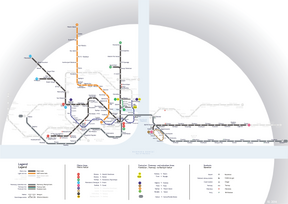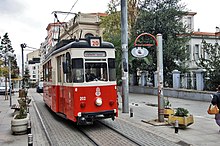T3 (Kadıköy-Moda Nostalgia Tramway)
| Basic data | |
| Country | Turkey |
|---|---|
| city | Istanbul |
| opening | November 1, 2003 |
| Lines | T3 |
| Route length | 2.6 km |
| Stations | 10 |
| use | |
| operator | İstanbul Ulaşım |
| Power system | Overhead line |
| station | location |
|---|---|
| Kadıköy - İDO- Metro | 40 ° 59 ′ 24 ″ N, 29 ° 1 ′ 19 ″ E |
| Iskele Camii | 40 ° 59 '26 "N, 29 ° 1' 23" E |
| Çarşı | 40 ° 59 ′ 28 "N, 29 ° 1 ′ 32" E |
| Altiyol | 40 ° 59 '22 "N, 29 ° 1' 44" E |
| Bahariye | 40 ° 59 '15 "N, 29 ° 1' 43" E |
| Kilise | 40 ° 59 ′ 9 ″ N, 29 ° 1 ′ 40 ″ E |
| Moda İlkokulu | 40 ° 59 ′ 3 ″ N, 29 ° 1 ′ 36 ″ E |
| Moda Caddesi | 40 ° 59 ′ 3 ″ N, 29 ° 1 ′ 28 ″ E |
| Mühürdar | 40 ° 59 ′ 7 ″ N, 29 ° 1 ′ 16 ″ E |
| Damga Sokak | 40 ° 59 ′ 17 ″ N, 29 ° 1 ′ 16 ″ E |
|
Kadıköy Moda Tramvay Deposu |
40 ° 59 ′ 21 ″ N, 29 ° 1 ′ 12 ″ E |
Line T3 (Kadıköy-Moda Nostalgia Tramway) is a museum tram line on the Asian side of Istanbul with a gauge of 1000 millimeters, which is operated by İstanbul Ulaşım .
The original Istanbul tram network was shut down in the 1960s. The last tram on the Asian side ran on October 3, 1966 between Kadiköy and Kızıltoprak . The remaining vehicles were then taken to the transport museum. The then introduced trolleybus traffic ended on July 16, 1984. This led to a sharp increase in individual traffic, traffic jams and air pollution.
In 1990 and 2003, two museum trams went into operation, one in the European and one in the Asian part of the city. On December 29, 1990, the T1 (Taksim-Tünel Nostalgia Tramway) with rail vehicles built according to old photos went into operation on the European side and quickly gained popularity, especially with tourists. From November 1, 2003 , trams taken over from Jena and Schöneiche near Berlin , which had been built in Berlin and Gotha, were used on the T3 line .
As a clockwise ring line, the T3 serves a 2.6 kilometer long route with ten stops, which roughly follows the previous tram line 20. There are no overtaking points on the single-track route.
The T3 line operates from 7:00 a.m. to 9:00 p.m., every ten minutes during rush hour. The travel time is 20 minutes for the entire route. The tickets cost 1.75 TL and around 2,000 passengers are carried daily.
vehicles
The two-axle cars 201 and 203, which have four windows on each side, are so-called reko cars , which were built in the Reichsbahn repair shop in Berlin-Schöneweide . They used to wear the number 138 in Jena and 75 in Schöneiche near Berlin.
Car 202 was built at the Gothaer Waggonfabrik . It belongs to the T57 series with three windows on each side and used to run in Jena with the number 102. Four other T57 trams built in Gotha with the numbers 104, 110, 112 and 115 were procured from Jena in 2006 and are now running with the numbers 204 –207 in Istanbul, but these are not numbered because of advertising imprints on the outside. Car 102 (now Istanbul 202), which was previously used in Jena, was built in 1958 and car 138 (now Istanbul 201) in 1973. Jena cars 104, 110, 112 and 115 were built in 1960, 1961, 1958 and 1959, and the three of the latter were used on the Görlitz tram until 1992 . The Schöneicher Wagen 75 (now Istanbul 203) was built in 1975 based on a design from the 1950s.
Web links
Individual evidence
- ↑ a b c d T3 Kadıköy Moda Nostaljik Tramvay ( Turkish ) İstanbul Ulaşim A.Ş. Retrieved December 11, 2015.
- ^ A b c d Mike Russell: "Heritage tramways across two continents". Tramways & Urban Transit , pp. 122-123. UK: LRTA Publishing. ISSN 1460-8324. March 2008.
- ^ A b Tramway & Light Railway Atlas Germany 1996 (1995), pp. 146, 224. Berlin: Arbeitsgemeinschaft Blickpunkt Strassenbahn eV / London: Light Rail Transit Association. ISBN 0-948106-18-2 .
- ^ Tram atlas Germany 2005 (2005), p. 148. Berlin: Arbeitsgemeinschaft Blickpunkt Straßenbahn eV. ISBN 3-926524-24-3 .


